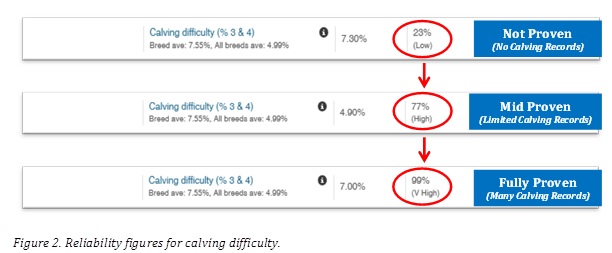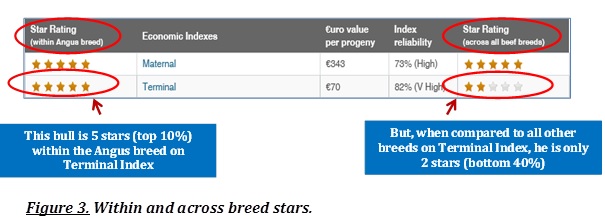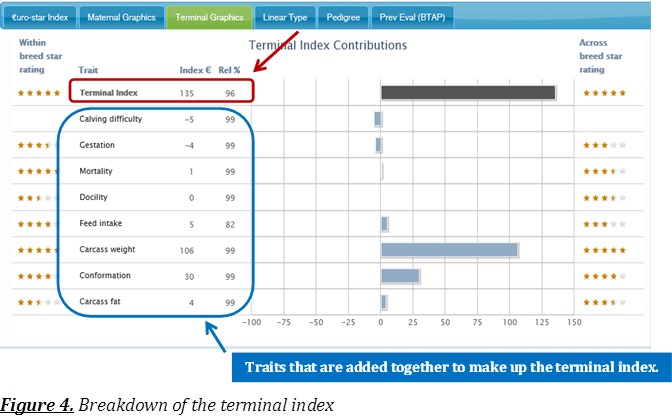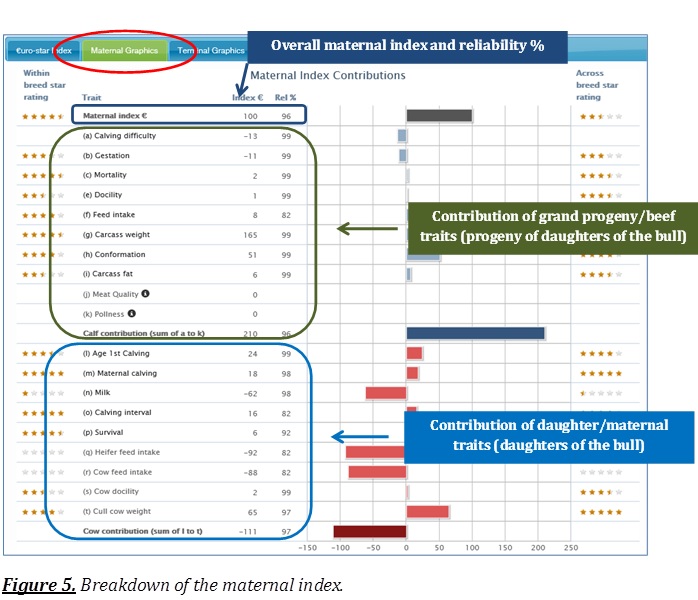This page has been put together in a question and answer format to help suckler farmers, breeders and agri-advisors better understand the beef Euro-Star Index. The questions have been generated based on feedback from discussion groups and agri-advisors.
Q. Where can I find the Euro-Star ratings of an AI bull or a stock bull?
A. You can find the Euro-Star ratings on the online bull search which is available at www.icbf.com. Type in the AI code of a bull or its tag number and click “Search”. You can also choose to search for a bull by its name or part of its name (See figure 1).
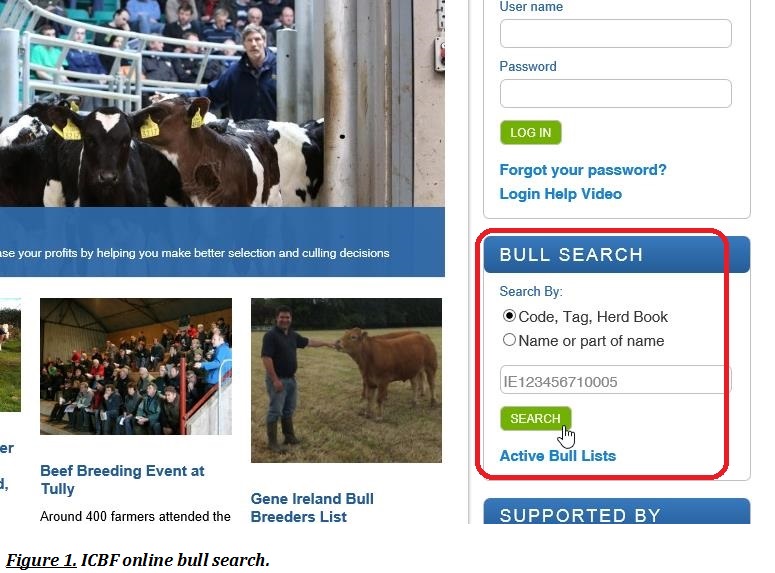 AI companies also include the Euro-Star figures on bulls in their catalogues. It is important to remember that Euro-Stars are updated three times per year (April, August and December). So, if you are looking at an old AI catalogue the Euro-Star figures will be out of date. The most up to date figures will always be available on the ICBF online bull search.
AI companies also include the Euro-Star figures on bulls in their catalogues. It is important to remember that Euro-Stars are updated three times per year (April, August and December). So, if you are looking at an old AI catalogue the Euro-Star figures will be out of date. The most up to date figures will always be available on the ICBF online bull search.
Q. What does the reliability % figure mean?
A. The reliability % figure is an indication of how well proven a bull is on a particular index or trait. The more data ICBF receives on a bull, the higher his reliabilities will climb. A bull with no progeny records will never have reliability figures above 50%. This is why young stock bulls or test AI bulls have low reliability figures. The Euro-Star figures for low reliability bulls are based on the indexes of their ancestry (sire and dam). Linear scoring can also have an impact on the index of a young bull. A bull can only realistically be called proven on any trait once he goes above 90% reliability on that trait (See figure 2).
Q. What do the stars on the index mean?
A. The stars on the index are used to rank bulls. The stars range from a ½ star (bottom 10%) to 5 stars (top 10%). There are within breed stars on the left hand side of the index which ranks a bull within his own breed and across breed stars on the right hand side which rank a bull against all breeds. It is important to remember that a bull’s within breed star ratings can be very different to his across breed star ratings (See figure 3).
Q. So should I use the within breed stars or the across breed stars?
A. If you are a pedigree breeder or a commercial farmer that always uses the same breed of bull, then you should focus on the within breed stars on the left hand side of the index. If, on the other hand, you are open to using a number of breeds, you should focus on the across breed stars on the right hand side and look for a high star rating on the traits that are important to you. Remember, if the reliabilities on an index or trait are low, then the bull is not proven on that index or trait.
Q. What do the terminal and maternal (replacement) indexes mean?
A. The terminal and maternal (replacement) indexes are overall monetary indexes that show the potential financial impact of using a bull in your herd. If you take the Charolais bull Pirate (PTE) as an example. Pirate has a terminal index of €135. This means that Pirate’s progeny will leave €135 extra profit at slaughter over the average animal. Pirate has a maternal (replacement) index of €100. This means that Pirate daughters that are used for breeding will leave €100 extra profit above the average suckler cow, over the course of their lifetime (all of their calves and their slaughter value). It is important to remember that these are average figures, therefore, on farms where management and performance are very high; Pirate progeny may leave a lot more profit than the index suggests. By the same token, on farms where management and performance are poor, Pirate progeny may well leave a lot less profit than the average.
Q. What is the terminal index made up of?
A. The terminal index is made up of the traits that are important to farmers that are breeding cattle for slaughter, or sale as weanlings/store cattle. Traits such as calving difficulty, feed intake and carcass weight are taken into account when generating an animal’s terminal index. The full makeup of an animal’s terminal index is outlined below: This can be accessed by clicking on “Terminal Graphics” on the online bull search (See figure 4).
Q. What is the maternal (replacement) index made up of?
A. The maternal (replacement) index is made up of the traits that are important to farmers breeding females intended as replacements. It is a little more complex than the terminal index. It looks at the maternal qualities of a bull’s daughters such as milking ability, fertility and calving ability, but also looks at the quality of the progeny that these daughters will in turn produce. Approximately half of the maternal (replacement) index is made up of beef traits. This is for two main reasons:
-
Half of any bull’s progeny will be males and in the vast majority of cases these will be destined for slaughter. So, even if a farmer purchases a bull with good maternal traits with the intention of breeding replacements, the bull still needs to pass on good beef traits to his male progeny.
-
As well as being strong on maternal traits such as milk, the daughters of a bull must be able to pass on strong beef genetics to their calves in order for them to make maximum use of the milk that they are consuming. A good way to explain this is to compare a beef suckler cow to a dairy milking cow. If suckler farmers used dairy bred females such as Holstein/Friesians or Jerseys as suckler cows, then they would be guaranteed an abundance of milk. However, these cows would pass on very poor beef traits to their calves and even though they would have access to a lot of milk, these calves would not possess the genetics to perform because of the influence of their dairy bred mothers. It is important to remember that half of the genetic makeup of any calf comes from the dam (mother), which means a good quality bull will not guarantee a good calf if the females he is being mated to have poor beef genetics. The full makeup of a bull’s maternal index is outlined below. This can be accessed through the online bull search by clicking on “Maternal Graphics” (See figure 5)
Q. Where can I find a breakdown of the calving difficulty figure of a bull?
A. You can access the breakdown of a bull’s calving difficulty figure through the online bull search. When you are looking at the online index (Euro-Star ratings) of a bull you can click on “Calving difficulty (% 3 & 4)” (See figure 6).
This will then take you to a screen which gives a full breakdown of the calving records of a bull (See figure 7).
Q. On the old Euro-Star index I found the weanling export trait very useful as I sell all of my calves as weanlings. How can I now judge from a bull’s index whether he breeds good weanlings or not?
A. The new Euro-Star index does not have a trait for weanling quality. However, you can get around this by using some of the other traits. The two main things that buyers look for at weanling sales are weight for age and shape. The overall terminal index, carcass weight and particularly carcass conformation traits are good indicators as to how suitable a bull should be to breed good quality weanlings. Some AI companies have added a weaning weight trait to the indexes in their catalogues which can also be used. A close eye should always be kept on the reliability % figures as well as on the calving difficulty % figure as difficult calvings are highly undesirable and lead to increased losses, labour and costs.
Q. Why does the best cow in my herd have a poor index?
A. This is a very common question among beef farmers and an understandable one. A high performing cow can have a poor index for a number of reasons:
- The cow is from poor back breeding. If the animals in the back pedigree of a cow bred poor progeny, then this will be reflected in the cow’s index. Her own performance on the ground will boost her index, but to a limited degree. This is because a cow can only ever have a relatively small number of progeny (10 calves would be a huge return), therefore she will not have enough progeny records to significantly improve her own index.
- The cow is from an outcross pedigree and ICBF has very few, if any, data records on these animals. The index of your cow may look very poor, but the reliability figures will also be very low.
Q. Why do some of my cows not have any index?
A. This is usually because these cows do not have a sire recorded. If the sire is unknown then a genetic index cannot be created for a cow as her ancestry is unknown. If you know the sires of these cows you can record them through your HerdPlus login by going to the “Record Missing Sires” screen.
Q. Everywhere I ask I get a different answer on what is an acceptable level of calving difficulty for maiden heifers. What level of calving difficulty should I stay below when picking a bull for my heifers?
A. Naturally, farmers desire ease of calving when it comes to heifers. Bulls with a low reliability figure for calving difficulty (less than 50%) will have few if any calving ease scores recorded on them, therefore there is a certain amount of risk if using such bulls on heifers. Ideally farmers should only use proven easy calving bulls on heifers, but sometimes this is not possible, particularly if a young stock bull is being used. If a farmer uses AI, then it is best to use bulls with a low calving difficulty figure (less than 5%) with a high reliability figure (greater than 90%). If a farmer buys a new stock bull, then if possible, avoiding using him on heifers for the first year would be good practise. By doing this a farmer can judge the calving difficulty of the bull on his cows before deciding whether or not to use him on heifers.
Q. In the Euro-Star index there is a trait for daughter milk. How does ICBF measure the milking ability of suckler cows?
A. The milking ability of suckler cows is gauged by the performance of their calves. Calves with the highest average daily gains (ADG’s) in a herd are almost always from the milkiest cows in that herd. In order for this performance to be reflected in genetic indexes, it must be measured and this is done by weighing suckler calves between 150-250 days of age (approx. 5-8 ½ months). A weight on a calf at this age is more commonly known as a “milk weight” and gives a good indication as to the milking ability of the cow that the calf is suckling.
On-farm weighing is good practice as it gives farmers a detailed insight into the performance of their animals and allows ICBF to reflect the milking performance of suckler cows in genetic evaluations. It is vital that farmers not only weigh their animals but also supply these weights to ICBF. Weights can be recorded through the ICBF website (HerdPlus®) or through a farm software package. If a farmer avails of the ICBF weighing service then weights are automatically uploaded to the ICBF database.
This is just an overview of the most frequently asked questions that ICBF receives on the new beef Euro-Star index. Obviously, farmers or advisors may have some other questions that are not included here. If you do have any other questions that you would like to have answered, please do not hesitate to contact ICBF HerdPlus® on 1850 600 900.

